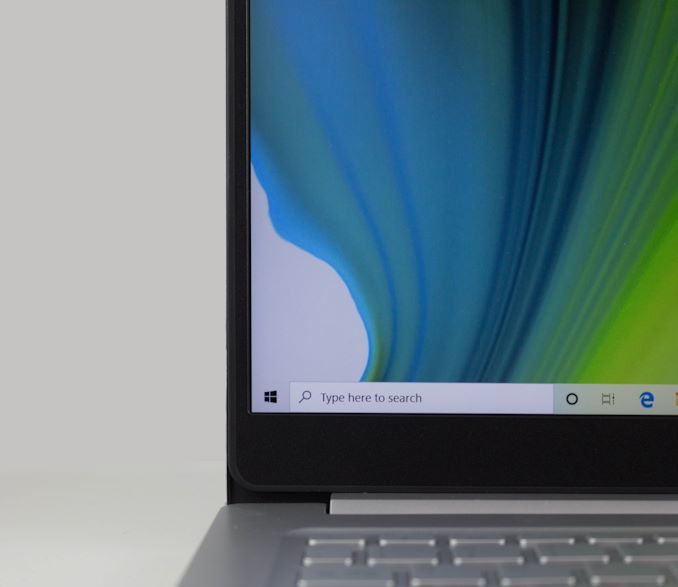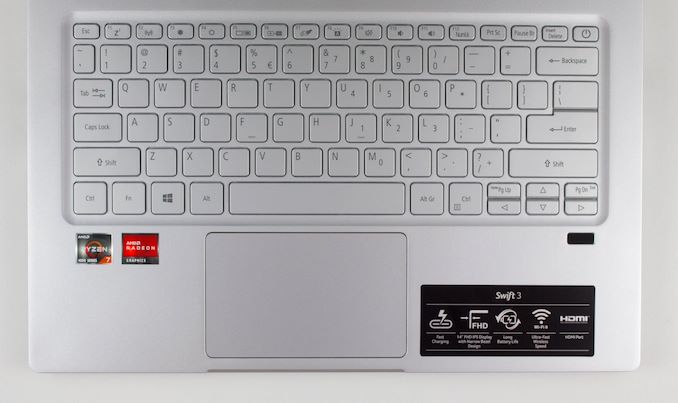The Acer Swift 3 SF314 Notebook Review: Swift Gets Swifter With Ryzen 4000
by Brett Howse & Andrei Frumusanu on May 5, 2020 8:00 AM ESTDesign
Acer’s design ethos for the new Swift 3 would make you think this is a much more expensive device. The 14-inch notebook features an all-aluminum design, offering a much more premium feel than what you’d normally expect on a notebook in this price range. At just 1.2 kg / 2.65 lbs, the 14-inch notebook is extremely portable, and with an 83% screen to body ratio, it is easily as compact as a 13.3-inch notebook from a couple of years ago. Acer’s choice of a 16:9 display does mean that the display has a hefty chin, but is almost certainly a choice that was made to keep the device in-budget.
Despite the thin design and the low price, the aluminum chassis is very stout, with little to no flex no matter how you pick it up. Acer has cut in a slot at the front to make opening the laptop easier, although it will not open with a single finger since the hinge is too stiff to allow this. There is no touch support either, so the hinge stiffness does not need to be quite so tight, but it does make for a solid platform once you open it up.
The keyboard provides a great typing experience. The keys themselves have single-level white backlighting, which works well. The white backlighting on silver keys can cause some contrast issues in bright light, but the effect is not as pronounced as it is on some other devices. Typing offers a surprisingly good keyboard feel, with solid keys that have a solid level of pressure and feedback. Acer has the power button as part of the keyboard, which does make it prone to accidentally turning the device off if you miss the delete key, and moving the power button out of the normal keys would be appreciated, but Acer is far from the only manufacturer to do this, and the laptop resumes instantly so even if it did happen it’s not as big of an issue as it was a few years ago, thanks to the new modern standby options built into Windows and the new CPU.
If there was one area where the notebook showcased it was a lower-cost device, it would be the trackpad. Although it offers the Precision touchpad drivers, the material is not as smooth and responsive as some higher-priced notebooks. This is not so much a knock against the device, but a reality of where it is situated in the market. It does offer the expected multi-touch capabilities you’d expect, it just doesn’t quite offer the level of refinement you’d see in more premium notebooks.
Acer has also included a fingerprint reader, which has great response. It unlocks the device in well under a second even if the display is off. It is a nice to see Windows Hello support despite the lower cost of this device, and the chosen reader seems to work very well. There is no IR camera included, and the built-in webcam is only a 1280x720 unit, so do not expect to be the belle of the Teams meeting, but it gets the job done with a properly located webcam in the top bezel.
Acer offers reasonable I/O as well, with a USB Type-C port on the left, which does support power delivery up to 15 Watts output, and support for charging the device via USB-C as well. There is no Thunderbolt 3, but it does offer DisplayPort output. This is in addition to the included HDMI port, and the laptop also has a USB 3.2 Gen 1 port on the left which supports power-off charging, and a USB 2.0 port on the right, along with a headset jack.
Overall, the Acer Swift 3 is a great design, with a modern feel, and premium materials. The 14-inch notebook is compact, thin, and light, and Acer has done a great job with the look and feel of this device. There are enough ports, and the included USB-C port adds the expanded ability to charge as well as I/O. Looking at this device, you could easily mistake it for a notebook that costs hundreds more.














191 Comments
View All Comments
psychobriggsy - Tuesday, May 5, 2020 - link
Yeah, but then you're stuck with two small SODIMMs to replace when you want more memory...My 2700U HP came with 1 8GB stick, buying another stick later on when I needed to double capacity was a lot cheaper than rebuying the full desired capacity.
OTOH 16GB isn't a lot these days - and I'd prefer to get the 16GB in soldered fast LPDDR4X form with Renoir and hope I never need 32GB!
ads295 - Tuesday, May 5, 2020 - link
So I guess you'd have to plan ahead, then. I was going to upgrade to 4x2 initially but I went with 8x2 after some consideration.But would you really need more than 16 if you're a casual user? What are your workloads like? I do light gaming, web browsing and that sort and even 8 would've been enough for me.
fmcjw - Tuesday, May 5, 2020 - link
Lenovo Yoga series was the worst with their single channel atrocities, hope they come to their senses in 2020.Swift 5 2020 (only offered with Intel, no AMD configs I know of) has 8GB onboard with an empty slot running in single channel, but I'm curious how many users think to add another stick. In that case 16GB of onboard RAM is better, at least it reduces BSOD from mismatched RAM.
BTW, if you add a 16GB SO-DIMM to the 8GB onboard, do you get at least the same performance and benefits as 16GB in dual channel mode, or does it create instabilities and other system-wide complications?
csp4me - Tuesday, May 5, 2020 - link
please check your sources man, Swift 5 2020 under 1 kg can never have empty slots, everything is soldered. https://www.notebookcheck.net/Acer-Swift-5-Laptop-...fmcjw - Wednesday, May 6, 2020 - link
You're right, thanks, I got it mixed up with the LG Gram (2020). Acer is soldered.Spunjji - Wednesday, May 6, 2020 - link
Adding a 16GB SO-DIMM to a system with 8GB soldered gives you dual-channel performance for the first 16GB pool of system RAM, with the remaining 8GB running at single-channel performance.neblogai - Tuesday, May 5, 2020 - link
Regarding RAM: at least in China, Swift 3 models with 8GB come with LPDDR4 3200, but there is also a 16GB version, and that uses LPDDR4X 4266, costing ~15% more. It came a ~month later than the 8G model.eddieobscurant - Tuesday, May 5, 2020 - link
I don't understand why they don't offer a model with more ram. 8gb, non-upgradable ram is too low.Holliday75 - Tuesday, May 5, 2020 - link
For who? Most business and casual users 8gb is plenty.My company has 10's of thousands of 8gb laptops deployed and we rarely see the need for more and my users love their huge ass spreadsheets and Chrome. Most home users like my family and friends would be fine with it as their workloads are not as robust.
Me personally I would like 16gb for home use as I game. At work I am happy with my 4th gen Intel processor and 8gb of RAM.
RinzImpulse - Wednesday, May 6, 2020 - link
Umm... don't forget that system RAM will be shared with iGPU, so, most likely you'll only get 6-7 GB free for windows which I'm sure it won't be enough even for most